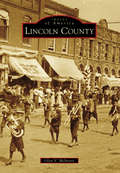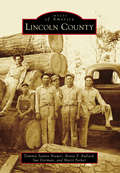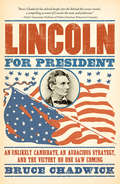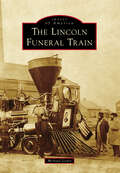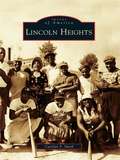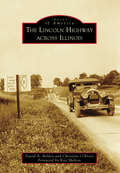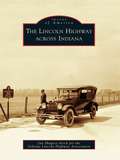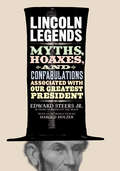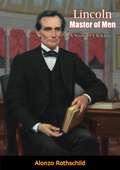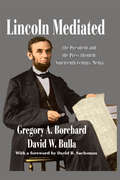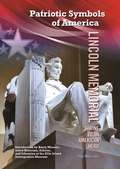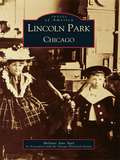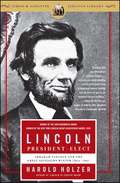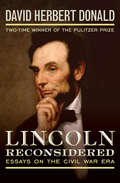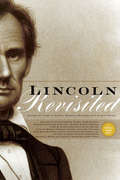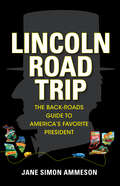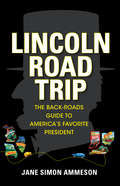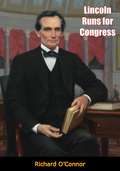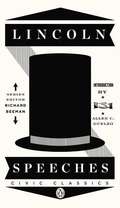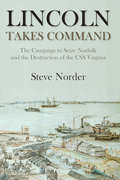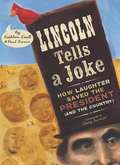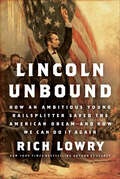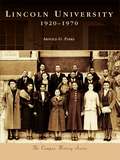- Table View
- List View
Lincoln County
by Glen V. McintyreTo the east of Oklahoma City, Lincoln County lies in east central Oklahoma with Chandler as its county seat. The county was opened by two land runs: the first on September 22, 1891, and again four years later on May 23, 1895. The land is primarily rolling grass hills covered with stands of blackjack oak and post oak and is part of what is called the Crosstimbers. Images of America: Lincoln County celebrates the different tribes that lived in the area: the Sac and Fox, the Iowa, and the Kickapoo. It also features famous lawman Bill Tilghman, Olympic athlete Jim Thorpe, poet Jennie Harris Oliver, and governors J.B.A. Robertson and Roy J. Turner. Oil came early to Lincoln County and continues to play a large role in the economy. At one time, the county was covered in cotton fields. It is also a center of transportation with several railroads, old Route 66, and the Turner Turnpike, which today is the major road connecting Oklahoma City and Tulsa.
Lincoln County (Images of America)
by Bettie P. Bullard Marti Parker Sue Dorman Tammie Santos BrewerOn April 7, 1870, an act of the state legislature created Lincoln County, named for Pres. Abraham Lincoln, from Lawrence, Franklin, Copiah, Pike, and Amite Counties. Settlement began more than 50 years earlier with Samuel Jayne's small trading post on St. Stephens Road. Extensive timber resources, the arrival of the railroad in 1857, and the 1859 founding of Whitworth Female College put the county on the map. Logging, lumber mills, and other industries brought scores of people to the region. The agricultural endeavors of cotton and farming provided a way of life before the oil boom of the 1940s. The varied ethnic and religious history of the residents further shaped the county into what exists today.
Lincoln For President
by Bruce ChadwickThe untold story of the drama, controversy, and incredible political genius of Lincoln's first presidential campaignIn May of 1860, Republican delegates gathered in Chicago for their second-ever convention, with the full expectation of electing William Seward their next presidential candidate. But waiting in the wings was a dark horse no one suspected, putting the final touches on a plan that would not only result in a most unexpected candidacy, but the most brilliant, innovative, and daring presidential campaign in American history. He went by the name of Lincoln. Lincoln for President is the incredible story of how Lincoln overcame overwhelming odds to not only capture his party's nomination but win the presidency. His amazingly modern strategy included the first media campaign blitz, convention tactics that originated the concept of "Chicago politics," and a deft manipulation of the electoral college. His bold tactics changed forever the way presidential campaigns are won...not to mention the course of American history. PRAISE FOR BRUCE CHADWICKTriumvirate:"Dr. Chadwick tells an exciting story... His analysis will provoke further debate about this momentous period in American history. " Dr. Paul Clemens, Chairman of the Rutgers University Department of History"In this remarkable new book, Bruce Chadwick reminds us of the three extraordinary men who worked state by state, individual by individual, to ensure passage of the Constitution. It's a fascinating tale, well told. " Terry Golway, author of Washington's General and Ronald Reagan's America 1858:"This book is a gem. " Curled Up With a Good Book "A gripping narrative. " Kurt Piehler, author of Remembering War the American Way The First American Army:"To understand the Revolutionary War, really understand it, read this book. " Dave R. Palmer, Lieutenant General, U. S. Army (Ret); author of The Way of the Fox George Washington's War:"Chadwick pierces the fog of myth that has always surrounded our nation's father. " Michael Aaron Rockland, professor, Rutgers University
Lincoln Funeral Train, The (Images of America)
by Michael LeavyThe effective end of the American Civil War on April 9, 1865, had hardly sunk in when, only five days later, another disaster stunned the battered and bloodied nation. On the night of April 9, Pres. Abraham Lincoln was assassinated. There would be time for vengeful thoughts later, but first the Great Emancipator was going to get a royal send-off. At the center of what would become a three-week national funeral was a spectacular train that would carry Lincoln's remains, and those of his deceased son, from Washington, DC, to Springfield, Illinois. "The Lincoln Special" steamed slowly out of spring mists, allowing thousands of mourners lining the tracks a lingering view. It was a logistics miracle; a romantic pageant of sorrow and wonder, carried off flawlessly. Through the tears, however, was a sense that America's identity had turned a corner and was about to enter a dynamic and hopeful future. Author of nine books, Michael Leavy is an avid Civil War and railroad historian. Leavy has searched through archives to locate rare photographs and new details and dispel some lingering myths surrounding this tragic but formative American event.
Lincoln Hall at the University of Illinois
by John HoffmannLincoln Hall at the University of Illinois, named to commemorate the centennial of Abraham Lincoln's birth, has long been a familiar landmark on the Urbana-Champaign campus and the home for undergraduate and graduate work in the liberal arts and communication. Funded by the Illinois State Legislature in 1909, the building was dedicated in 1913 on Lincoln's birthday, February 12. In addition to its function as space for offices, classrooms, and departmental libraries, Lincoln Hall was commissioned, designed, and built to convey "the wisdom and patriotism of the democracy of learning." That spirit of freedom and equality in education was manifest in Lincoln Hall's artistic design, which features terra cotta panels depicting Lincoln's life, quotations from his writings, and portraits of prominent figures of his day. At the outset of the building's conception, Evarts B. Greene, professor of history and dean of the College of Literature and Arts, provided detailed information about Lincoln that defined the building's artistic program. Wishing to retain the dignified simplicity of the overall design, he conferred with W. Carbys Zimmerman, the State Architect, about the nature and placement of the panels and other ornamental details that have become key features of the building's design. Commemorating the bicentennial of Lincoln's birth, this magisterial volume chronicles the history of Lincoln Hall from its conception to its expansion and its present role on the campus. John Hoffmann identifies each of the building's historical panels and the portraits of Lincoln's contemporaries. Lavishly illustrated to show how much care was taken with the details of the design, this book provides a lasting historical record of the building's century-long place at the University of Illinois. Supported by the Office of the Chancellor of the University of Illinois at Urbana-Champaign
Lincoln Heights (Images of America)
by Carolyn F. SmithLocated north of Cincinnati in the Mill Creek Valley, Lincoln Heights was the first African American self-governing community north of the Mason-Dixon Line. The development of Lincoln Heights began in 1923 when the Haley-Livingston Land Company of Chicago sold lots to black families in an unincorporated area called the Cincinnati Industrial Subdivision, now the southern section of Lincoln Heights. Water and sewerage were provided by special assessment through the Works Progress Administration, there were no building and zoning code services, fire and police protection were virtually nonexistent, and street maintenance and lighting were extremely inadequate. In 1939, residents of the area began efforts to incorporate so they could provide safety and necessary services for their growing community. Several of the original petitioners for incorporation lived in the Valley View subdivision, which later became the Wright Aeronautical plant, where many black migrants from the South came to help manufacture the famous B-29 bomber.
Lincoln Highway Across Illinois, The
by David A. Belden Christine R. O’brien Kay SheltonFrom southern Cook County to the Mississippi River, the Lincoln Highway meanders through many of Chicago's suburbs before heading west through Illinois's fertile farmland. America's first transcontinental highway once stretched nearly 3,400 miles from New York City to San Francisco. The story of the highway's role in shaping the contemporary American highway system is one that examines the interaction of technology and human spirit. Conceived by entrepreneur Carl G. Fischer in 1912 and endorsed by businessman Henry B. Joy, the idea of creating an automobile-friendly roadway spanning America would soon change the nature of travel in the 20th century. Lincoln Highway in Illinois defines and describes the role of the highway as it zigzags its way across the "Land of Lincoln" and highlights the cities, towns, and rural communities along its route.
Lincoln Highway across Indiana, The
by Jan Shupert-Arick Indiana Lincoln Highway AssociationThe Lincoln Highway across Indiana explores Indiana's unique role in Lincoln Highway history and celebrates Indiana's place in early automotive and road-building history. Once known as the "Main Street of America," the Lincoln Highway route was established across northern Indiana in 1913, linking larger cities--Fort Wayne, Elkhart, Goshen, South Bend, LaPorte, and Valparaiso--to smaller communities. Most Lincoln Highway towns renamed their main streets Lincolnway in recognition of the nation's first coast-to-coast auto road. When the Lincoln Highway Association shortened the route in 1926, the route linked Fort Wayne to Columbia City, Warsaw, and Plymouth, giving the state two Lincoln Highway routes. From Fort Wayne to the famous Ideal Section, between Dyer and Schererville, Indiana's Lincolnway towns remain proudly connected to Lincoln Highway history. Through vintage photographs, postcards, advertisements, and other historical records, this armchair tour of the highway visits sites favored by early tourists, documents the people and places that made the highway a vital corridor, and celebrates Hoosier Carl Fisher's leadership in the formation of the Lincoln Highway Association, as well as the people who work to preserve its legacy today.
Lincoln Legends: Myths, Hoaxes, and Confabulations Associated with Our Greatest President
by Edward Steers Jr.&“Succinctly and eloquently debunks 14 popular myths about the Great Emancipator's life and death [with] solid documentation.&” —Publishers Weekly In the more than 150 years since his death, Abraham Lincoln has become America&’s most revered president. The mythmaking about this self-made man began early, some of it starting during his campaign for the presidency in 1860. As an American icon, Lincoln has been the subject of speculation and inquiry as authors and researchers have examined every aspect― personal and professional ―of the president&’s life. In Lincoln Legends, noted historian and Lincoln expert Edward Steers Jr. carefully scrutinizes some of the most notorious tall tales and distorted ideas about America&’s sixteenth president. Did he write his greatest speech on the back of an envelope on the way to Gettysburg? Did he appear before a congressional committee to defend his wife against charges of treason? Was he an illegitimate child? Did he have romantic encounters with women other than his wife—or love affairs with men? What really happened in the weeks leading up to April 14, 1865, and in the aftermath of Lincoln;s tragic assassination? Lincoln Legends evaluates the evidence on all sides of the many heated debates about the Great Emancipator, and also traces the often fascinating evolution of flawed theories about Lincoln and the motivations of the individuals―occasionally sincere but more often cynical, self-serving, and nefarious―who are responsible for their dispersal. Based on extensive primary research, Lincoln Legends will settle many of the enduring questions and persistent myths about Lincoln&’s life once and for all. &“Fascinating reading.&” —Tucson Citizen
Lincoln Master of Men: A Study of Character
by Alonzo RothschildAbraham Lincoln (1809–1865) is one of the most famous Americans in history and one of the country’s most revered presidents. Schoolchildren can recite the life story of Lincoln, the “Westerner” who educated himself and became a self made man, rising from lawyer to leader of the new Republican Party before becoming the 16th President of the United States. Lincoln successfully navigated the Union through the Civil War but didn’t live to witness his crowning achievement, becoming the first president assassinated when he was shot at Ford’s Theater by John Wilkes Booth on April 14, 1865. In the generation after the Civil War, Lincoln became an American deity and one of the most written about men in history. With such a sterling reputation, even historians hesitate to write a critical word; in Team of Rivals Doris Kearns Goodwin casts Lincoln as an almost superhuman puppet master in control of his Cabinet’s political machinations and the war’s direction, juggling the balancing act flawlessly. As a result, Lincoln the man is far less known than Lincoln the myth.-Print ed.
Lincoln Mediated: The President and the Press Through Nineteenth-Century Media (Journalism Ser.)
by David W. BullaLincoln Mediated provides new information about a historical figure everyone thinks they know. It describes how Abraham Lincoln worked with the press throughout his political career, beginning with his service in Congress in the late 1840s, and detailing how his ties to newspapers in Illinois, New York, and Washington played a central role in the success of his presidency. Gregory A. Borchard and David W. Bulla study how Lincoln used the press to deliver his written and spoken messages, how editors reacted to the president, and how Lincoln responded to their criticism. Reviewing his public persona through the lens of international media and visually based sources, a fascinating profile emerges.The authors cite the papers of Lincoln, the letters of influential figures, and content from leading newspapers. The book also features nineteenth-century illustrations and photographs. Lincoln Mediated ties the president's story directly to the press, illuminating his role as a writer and as a participant in making the news. Lincoln's legacy cannot be understood without understanding the role the press played in helping shape how he was viewed. As the authors show, Lincoln was a man, not just a political figure. Lincoln Mediated is a worthy addition to Transaction's Journalism series.
Lincoln Memorial: Shrine to an American Hero
by Hal MarcovitzIn November 1860, Abraham Lincoln was elected as the 16th president of the United States. By the time Lincoln took office in March 1861, the country was in crisis, as 11 states had declared their intention to secede and form a new nation, the Confederate States of America. More than four bloody years of civil war followed. Lincoln managed the government's effort to put down the rebellion and restore harmony to the country, and in the process set the nation on the path toward ending slavery forever. The Lincoln Memorial on the National Mall in Washington, D.C., commemorates Lincoln's accomplishments, as well as his personal belief in the dignity and inherent equality of all people. It has been the site of many large gatherings and protests. For millions of Americans, the Lincoln Memorial remains an inspiring symbol of freedom.
Lincoln Park, Chicago
by Chicago Historical Society Melanie Ann ApelSince it was founded by German immigrants in the late 1800s, Chicago's Lincoln Park neighborhood has been an exciting and ever-changing place to live. Bordered by Diversey, Ashland, North Avenue, and Lake Michigan, Lincoln Park has undergone countless changes while always remaining a strong Chicago community.Through a collection of more than 200 photographs, Lincoln Park, Chicago offers the reader a journey through homes, schools, businesses, museums, churches, the Lincoln Park Zoo, and the park itself. With anecdotes and images from before the Great Chicago Fire of 1871, to the 1940s when war turned family homes into rooming houses, to the bustling, jam-packed Lincoln Park of today, this vibrant and beautiful neighborhood springs to life.
Lincoln President-Elect
by Harold HolzerOne of our most eminent Lincoln scholars, winner of a Lincoln Prize for his Lincoln at Cooper Union, examines the four months between Lincoln's election and inauguration, when the president-elect made the most important decision of his coming presidency -- there would be no compromise on slavery or secession of the slaveholding states, even at the cost of civil war. Abraham Lincoln first demonstrated his determination and leadership in the Great Secession Winter -- the four months between his election in November 1860 and his inauguration in March 1861 -- when he rejected compromises urged on him by Republicans and Democrats, Northerners and Southerners, that might have preserved the Union a little longer but would have enshrined slavery for generations. Though Lincoln has been criticized by many historians for failing to appreciate the severity of the secession crisis that greeted his victory, Harold Holzer shows that the presidentelect waged a shrewd and complex campaign to prevent the expansion of slavery while vainly trying to limit secession to a few Deep South states. During this most dangerous White House transition in American history, the country had two presidents: one powerless (the president-elect, possessing no constitutional authority), the other paralyzed (the incumbent who refused to act). Through limited, brilliantly timed and crafted public statements, determined private letters, tough political pressure, and personal persuasion, Lincoln guaranteed the integrity of the American political process of majority rule, sounded the death knell of slavery, and transformed not only his own image but that of the presidency, even while making inevitable the war that would be necessary to make these achievements permanent. Lincoln President-Elect is the first book to concentrate on Lincoln's public stance and private agony during these months and on the momentous consequences when he first demonstrated his determination and leadership. Holzer recasts Lincoln from an isolated prairie politician yet to establish his greatness, to a skillful shaper of men and opinion and an immovable friend of freedom at a decisive moment when allegiance to the founding credo "all men are created equal" might well have been sacrificed.
Lincoln Reconsidered: Essays on the Civil War Era (Vintage Civil War Library)
by David Herbert DonaldA &“brilliant&” look at America&’s sixteenth president by the New York Times–bestselling, Pulitzer Prize–winning author of Lincoln (American Historical Review). First published in 1956 and revised and updated for the twenty-first century, Lincoln Reconsidered is a masterpiece of Civil War scholarship. In a dozen eloquent, witty, and incisive essays, the author of the definitive biography of Abraham Lincoln offers a fresh perspective on topics previously shrouded in myth and hagiography and brings the president&’s tough-mindedness, strategic acumen, and political flexibility into sharp focus. From Lincoln&’s patchwork education to his contradictory interpretations of the Constitution and the legacy of the Founding Fathers, David Herbert Donald reveals the legal mind behind the legend of the Great Emancipator. &“Toward a Reconsideration of the Abolitionists&” sheds new light on the radicalism of the antislavery movement, while &“Herndon and Mary Lincoln&” brilliantly characterizes the complicated relationship between two of the president&’s closest companions. &“Getting Right with Lincoln&” and &“The Folklore Lincoln&” draw on the methods of cultural anthropology to produce a provocative analysis of Lincoln as symbol. No historian has done more to enhance our understanding of Lincoln&’s presidency and the causes and effects of the Civil War than Donald. Lincoln Reconsidered is an entertaining and accessible introduction to his work and a must-read for every student of American history.
Lincoln Revisited: New Insights from the Lincoln Forum
by Harold Holzer Dawn VogelIn February 2009, America celebrates the bicentennial of the birth of Abraham Lincoln, and the pace of new Lincoln books and articles has already quickened. From his cabinet’s politics to his own struggles with depression, Lincoln remains the most written-about story in our history. And each year historians find something new and important to say about the greatest of our Presidents.Lincoln Revisited is a masterly guidePub to what’s new and what’s noteworthy in this unfolding story—a brilliant gathering of fresh scholarship by the leading Lincoln historians of our time. Brought together by The Lincoln Forum, they tackle uncharted territory and emerging questions; they also take a new look at established debates—including those about their own landmark works.Here, these well-known historians revisit key chapters in Lincoln’s legacy—from Matthew Pinsker on Lincoln’s private life and Jean Baker on religion and the Lincoln marriage to Geoffrey Perret on Lincoln as leader and Frank J. Williams on Lincoln and civil liberties in wartime.The eighteen original essays explore every corner of Lincoln’s world—religion and politics, slavery and sovereignty, presidential leadership and the rule of law, the Second Inaugural Address and the assassination.In his 1947 classic, Lincoln Reconsidered, David Herbert Donald confronted the Lincoln myth. Today, the scholars in Lincoln Revisited give a new generation of students, scholars, and citizens the perspectives vital for understanding the constantly reinterpreted genius of Abraham Lincoln.
Lincoln Road Trip: The Back-Roads Guide to America's Favorite President
by Jane Simon Ammeson“An engagingly written, personable, and intimate portrait of a president that walks in his footsteps and creates a cultural contextual lens through travel.” —Library JournalAmerica’s favorite president sure got around. Before Abraham Lincoln’s sojourned to the Oval Office, he grew up in Kentucky and began his career as a lawyer in Illinois. In fact, Lincoln toured some amazing places throughout the Midwest in his lifetime. In Lincoln Road Trip: The Back-Roads Guide to America’s Favorite President, Jane Simon Ammeson will help you step back into history by visiting the sites where Lincoln lived and visited.This fun and entertaining travel guide includes the stories behind the quintessential Lincoln sites, while also taking you off the beaten path to fascinating and lesser-known historical places. Visit the Log Inn in Warrenton, Indiana (now the oldest restaurant in the state), where Lincoln stayed in 1844 when he was campaigning for Henry Clay. Or visit key places in Lincoln’s life, like the home of merchant Colonel Jones, who allowed a young Abe to read all his books, or Ward’s Academy, where Mary Todd Lincoln attended school.Along with both famous and overlooked places with Lincoln connections, Ammeson profiles nearby attractions to round out your trip, like Holiday World, a family-owned amusement park that goes well with a trip to the Lincoln Boyhood National Memorial and Lincoln State Park. Featuring new and exciting Lincoln tales from Springfield, Illinois; Beardstown, Kentucky; Booneville, Indiana; Alton, Illinois; and many more, Lincoln Road Trip is a fun adventure through America’s heartland that will bring Lincoln’s incredible story to life.
Lincoln Road Trip: The Back-Roads Guide to America’s Favorite President
by Jane Simon AmmesonAmerica's favorite president sure got around. From his time as a child in Kentucky, as a lawyer in Illinois, and all the way to the Oval Office, Abraham Lincoln toured across the countryside and cities and stayed at some amazing locations. In Lincoln Road Trip: The Back-Roads Guide to America's Favorite President, Jane Simon Ammeson will help you step back into history by visiting the sites where Abe lived and visited. This fun and entertaining travel guide includes the stories behind the quintessential Lincoln sites, but also takes you off the beaten path to fascinating and lesser-known historical places. Visit the Log Inn in Warrenton, Indiana (now the oldest restaurant in the state), which opened in 1825 and where Lincoln stayed in 1844, when he was campaigning for Henry Clay. You can also visit key places in Lincoln's life, like the home of merchant Colonel Jones, who allowed a young Abe to read all his books, or Ward's Academy, where Mary Todd Lincoln attended school. Along with both famous and overlooked places with Lincoln connections, Jane Simon Ammeson profiles nearby attractions to round out your trip, like Holiday World & Splashin' Safari, a third-generation family-owned amusement park that can be partnered with a trip to the Lincoln Boyhood National Memorial and Lincoln State Park. Featuring new and exciting Lincoln tales from Springfield, IL; Beardstown, KY; Booneville, IN; Alton, IL; and many more, Lincoln Road Trip is a fun adventure through America's heartland that will bring Lincoln's incredible story to life.
Lincoln Runs for Congress
by Prof. Donald W. Riddle“THIS study of Lincoln’s campaign for nomination and election to Congress is offered as a report of an episode in Western history, rather than as a chapter of Lincoln biography. In the broadest sense it is a documentation of the Frederick Jackson Turner hypothesis of the significance of the frontier. Its potential contribution to Lincoln biography is within the framework of frontier history. The regional factors in the settlement of Illinois enable the understanding of the emergence of political attitudes and parties in a frontier state, and Lincoln’s early career can be understood as the issues and viewpoints of Illinois politicians were shaped by the regional influences in western settlement.“If the estimate of Congressman A. G. Riddle—that Lincoln was a consummate manager of men—is correct, Lincoln’s finesse in political technique is discovered to be no sudden acquisition at the time of his election to the presidency, but a skill developed in the formative days of his career as an Illinois politician. Lincoln’s ability as a minority President is much more readily understood when his leadership in a minority party in his state is studied. His success in handling the border slave states in the secession crisis was made possible by what he learned as a local politician in a region which had been settled largely by emigrants from Kentucky and Tennessee.” (Donald W. Riddle, Preface)
Lincoln Speeches
by Abraham LincolnThis is an EXACT reproduction of a book published before 1923. This IS NOT an OCR'd book with strange characters, introduced typographical errors, and jumbled words. This book may have occasional imperfections such as missing or blurred pages, poor pictures, errant marks, etc. that were either part of the original artifact, or were introduced by the scanning process. We believe this work is culturally important, and despite the imperfections, have elected to bring it back into print as part of our continuing commitment to the preservation of printed works worldwide. We appreciate your understanding of the imperfections in the preservation process, and hope you enjoy this valuable book.
Lincoln Steffans
by Justin KaplanThe acclaimed Pulitzer Prize winning biographer of Mark Twain and Walt Whitman brings alive the life and world of Lincoln Steffens, the original Muckraker and father of American investigative journalism. Early 20th century America was a nation in the throes of becoming a great industrial power, a land dominated by big business and beset by social struggle and political corruption. It was the era of Sinclair Lewis, Emma Goldman, William Randolph Hearst, and John Reed. It was a time of union busting, anarchism, and Tammany Hall. Lincoln Steffens—eternally curious, a worldwide celebrity, and a man of magnetic charm—was a towering figure at the center of this world. He was friends with everyone from Teddy Roosevelt and Woodrow Wilson to Ernest Hemingway and James Joyce. As an editor at McClure’s magazine—along with Ida Tarbell he was one of the original muckrakers—he published articles that exposed the political and social corruption of the time. His book, Shame of the Cities, took on the corruption of local politics and his coverage of bad business practices on Wall Street helped lead to the creation of the Federal Reserve. Lincoln Steffens was truly a man of his season, and his life reflects his times: impetuous, vital, creative, striving. In telling the story of this outsized American figure, Justin Kaplan also tells the riveting tale of turn-of-the-century America.
Lincoln Takes Command: The Campaign to Seize Norfolk and the Destruction of the CSS Virginia
by Steve NorderA detailed history of one week during the Civil War in which the American president assumed control of the nation&’s military. One rainy evening in May, 1862, President Abraham Lincoln boarded the revenue cutter Miami and sailed to Fort Monroe in Hampton Roads, Virginia. There, for the first and only time in our country&’s history, a sitting president assumed direct control of armed forces to launch a military campaign. In Lincoln Takes Command, author Steve Norderdetails this exciting, little-known week in Civil War history. Lincoln recognized the strategic possibilities offered by Maj. Gen. George B. McClellan&’s ongoing Peninsula Campaign and the importance of seizing Norfolk, Portsmouth, and the Gosport Navy Yard. For five days, the president spent time on sea and land, studied maps, spoke with military leaders, suggested actions, and issued direct orders to subordinate commanders. He helped set in motion many events, including the naval bombardment of a Confederate fort, the sailing of Union ships up the James River toward the enemy capital, an amphibious landing of Union soldiers followed by an overland march that expedited the capture of Norfolk, Portsmouth, and the navy yard, and the destruction of the Rebel ironclad CSS Virginia. The president returned to Washington in triumph, with some urging him to assume direct command of the nation&’s field armies. The week discussed in Lincoln Takes Command has never been as heavily researched or told in such fine detail. The successes that crowned Lincoln&’s short time in Hampton Roads offered him a better understanding of, and more confidence in, his ability to see what needed to be accomplished. This insight helped sustain him through the rest of the war.
Lincoln Tells a Joke
by Kathleen KrullPoor Abraham Lincoln! His life was hardly fun at all. A country torn in two by war, citizens who didn’t like him as president, a homely appearance-what could there possibly be to laugh about? And yet he did laugh. Lincoln wasn’t just one of our greatest presidents. He was a comic storyteller and a person who could lighten a grim situation with a clever quip. This unusual biography of Lincoln highlights his life and presidency, focusing on what made his sense of humor so distinctive-and so necessary to surviving his tough life and times.
Lincoln Unbound: How an Ambitious Young Railsplitter Saved the American Dream---And How We Can Do It Again
by Rich LowryIn this thoughtful mix of history and politics, the New York Times bestselling author and editor of National Review—the conservative bible founded by William F. Buckley, Jr.—traces Abraham Lincoln's ambitious climb from provincial upstart to political powerhouse and calls for a renewal of the Lincoln ethic of relentless striving.Revered today across the political spectrum, Abraham Lincoln believed in a small but active government in a nation defined by aspiration. Fired by an indomitable ambition from a young age, the man who would be immortalized as the "railsplitter" never wanted to earn his living with an ax. He educated himself in a frontier environment characterized by mind-numbing labor and then turned his back on that world. All his life, he preached a gospel of work and discipline toward the all-important ends of self-improvement and individual advancement. As a Whig and then a Republican, he worked to smash the rural backwardness in which he was raised and the Southern plantation economy that depended on human bondage.Both were unacceptably stultifying of human potential. In short, Lincoln lived the American Dream and succeeded in opening a way to it for others. He saw in the nation's founding documents the unchanging foundation of an endlessly dynamic society. He embraced the market and the amazing transportation and communications revolutions beginning to take hold. He helped give birth to the modern industrial economy that arose before the Civil War and that took off after it.His vision of an upwardly mobile society that rewards and supports individual striving was wondrously realized. Now it is under threat. Economic stagnation and social breakdown are undermining mobility and the American way. To meet these challenges, Rich Lowry draws us back to the lessons of Lincoln. It is imperative, he argues, to preserve a fluid economy and the bourgeois virtues that make it possible for individuals to thrive within it.
Lincoln University: 1920-1970 (Campus History)
by Arnold G. ParksLincoln University was founded in 1866 for the education of freed blacks after the Civil War. This book focuses on the years between 1920 and 1970, a span of time during which many of the university'smost signifi cant developments occurred. During this period, Lincoln Institute was elevated to university status, and graduate programs were added to the curriculum. A court-ordered law school was established and graduated many accomplished and respected African American attorneys before disbanding in the 1950s. During this era, the university was often referred to as "the Harvard of the Midwest" due to the acclaimed reputation of its faculty. Many alumni have made outstanding contributions at local, state, and national levels. After the 1954 United States Supreme Court Brown v. Board of Education of Topeka decision, the university integrated its student body. As a result, student enrollment changed dramatically from all black to a signifi cantly white clientele. Today the university retains its designation as a historicallyblack college/university.
